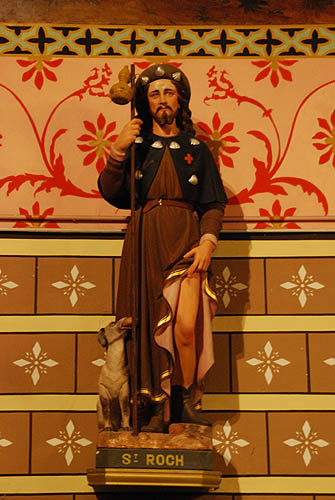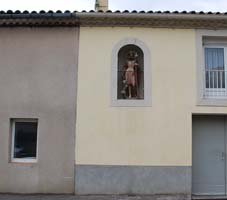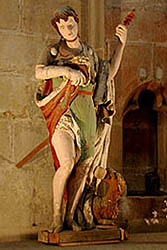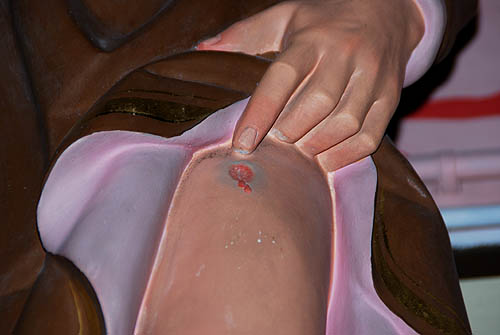
![]() In
almost every church in the Languedoc you will find a representation
of a saint who is relatively little known elsewhere. He
is Saint Roch, a confessor who was born around 1295 and
whose death is commemorated on 16 August. He is specially
invoked by the Catholic faithful against the Bubonic Plague
and other infectious diseases.
In
almost every church in the Languedoc you will find a representation
of a saint who is relatively little known elsewhere. He
is Saint Roch, a confessor who was born around 1295 and
whose death is commemorated on 16 August. He is specially
invoked by the Catholic faithful against the Bubonic Plague
and other infectious diseases.
Like so many saints, Roch was not a real person, his biography is a reprocessed version of an older story about someone else. Most of the traditional information about him, still believed by some, comes from Church legends like the Legenda Aurea, which do not represent reliable history.
According to his Acta and his vita in Legenda Aurea, he was born at Montpellier, about 1295, the son of the Governor of that city, born of an Italian mother. According the same source he showed marked sanctity from an early age - for example suckling his mother in time to her religious fasting regime.
Around the age of 20, on the death of his parents, he distributed all his worldly goods among the poor and set out as a mendicant pilgrim. Arriving in Italy during an epidemic of plague, he helped tend the sick in the public hospitals at Acquapendente, Cesena and Rome, and is said to have effected miraculous cures. At Rome he cured the cardinal of Angleria (the pope's brother) by making the mark of the cross on his forehead. He cured cattle using the same technique.
|
On his return incognito to Montpellier Roch was arrested as a spy by order of his own uncle and thrown into prison, where he languished five years and died on 16 August 1327. Only when he was dead did the townspeople recognised him (by a birthmark). Soon, he was credited with continuing to work miracle cures against the pestilence, and he was soon canonised. Almost identical stories were related about numerous other saints. |
|
As San Rocco he became a patron saint of the city of Potenza, Italy. When the Council of Constance was threatened with plague in 1414, public processions and prayers for the intercession of Roch were ordered.

![]() His
cult spread through Spain, France, Belgium, Italy and Germany,
when he was often interpolated into the roster of the Fourteen
Holy Helpers, whose veneration spread in the wake of the
Black Death. He is known by different names in different
places: As well as Roch, he is Rochus (Latin), Rocco (Italian),
and Roque (Occitan,
Spanish and Portuguese):; Rock (English) and Rollock (in
Scotland)
His
cult spread through Spain, France, Belgium, Italy and Germany,
when he was often interpolated into the roster of the Fourteen
Holy Helpers, whose veneration spread in the wake of the
Black Death. He is known by different names in different
places: As well as Roch, he is Rochus (Latin), Rocco (Italian),
and Roque (Occitan,
Spanish and Portuguese):; Rock (English) and Rollock (in
Scotland)
At Ferrara in 1439, the cessation of the Black Death was attributed to St. Roch. For centuries the people of the Languedoc lived in fear of recurrences of the Black Death and later the Plague. This explains why St Roch was always such a favourite here.
Today, the Bubonic plague and similar diseases that killed so many in Medieval and Renaissance times have been brought under control by medical advances. But people still appeal to St Roch for his miraculous intercession, including AIDS suffers among the devout.
Roch's statues in Languedoc churches and displayed on house sides are readily identifiable. Here are the things to look for:
- He is represented in the garb of a bearded pilgrim, often with a pilgrim's hat and staff, and sometimes with misleading sea shells of St Jacques de Compostella.
- He hoists his pilgrim's garb to reveal a modest wound on his thigh (rather than on his less modest groin which would be more medically accurate as this is where buboes first appear). Often he points at the buboe to identify himself more clearly.
- He is accompanied by a dog carrying a loaf - generally depicted as a bread bun - in its mouth.
 |
 |
 |
The main railway station in Montpellier is named after St. Roch, as are a city church and many squares and streets.
Saint Roch's (or Rocco's) procession is featured in the film The Godfather Part II.
|
St Roch
|
St Roch
|
St Roch
|
St Roch
|
St Roch
|
 |
 |
 |
 |
 |

![]()

![]() The
plague (Fr Peste) affected not only the Languedoc
but also Provence,
and indeed the whole of Europe. It was however particularly
prevelant around the Gulf of Lyon, possibly because of the
clement weather. For more on the plague and its history
in Provence click on the following link which will open
a new window to Beyond
the French Riviera www.beyond.fr
The
plague (Fr Peste) affected not only the Languedoc
but also Provence,
and indeed the whole of Europe. It was however particularly
prevelant around the Gulf of Lyon, possibly because of the
clement weather. For more on the plague and its history
in Provence click on the following link which will open
a new window to Beyond
the French Riviera www.beyond.fr ![]() .
At one point during the Great Plague an Act of the Parliament
of Aix decreed the death penalty for any communication between
Marseille and the rest of Provence. A plague wall (Mur de
la Peste) was built across the countryside. It was, 2 m
high and 70 cm thick, with guard posts set back along its
length. For more on the plague wall click on the following
link which will open a new window to Beyond
the French Riviera www.beyond.fr
.
At one point during the Great Plague an Act of the Parliament
of Aix decreed the death penalty for any communication between
Marseille and the rest of Provence. A plague wall (Mur de
la Peste) was built across the countryside. It was, 2 m
high and 70 cm thick, with guard posts set back along its
length. For more on the plague wall click on the following
link which will open a new window to Beyond
the French Riviera www.beyond.fr ![]() .
.
|
Saint Roch wearing his pilgrim's outfit |
 |
|
Saint Roch pointing out his modestly placed buboe |
 |
|
Saint Roch's Canine Companion with a bread bun in his mouth |
 |
 |
|
Saint Roch at Rennes-le-Château |
Damaged Saint Roch at St-Martin's, Limoux |
|
|
|






